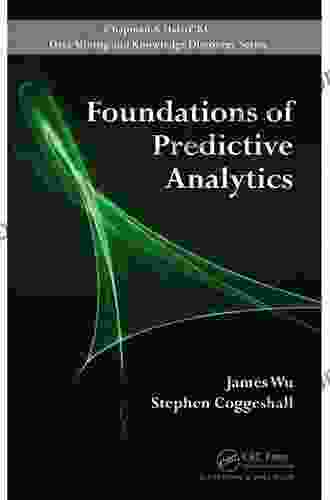Foundations of Predictive Analytics: Chapman & Hall/CRC Data Mining and Knowledge Discovery Series

Predictive analytics is a branch of data mining that uses statistical techniques to predict future events. It is used in a wide variety of industries, including healthcare, finance, marketing, and retail. Predictive analytics can help businesses make better decisions, reduce risk, and improve customer satisfaction.
This book provides a comprehensive overview of predictive analytics and its applications. It covers the foundations of predictive analytics, including data mining, machine learning, and statistical modeling. The book also discusses the challenges and ethical considerations of using predictive analytics.
Predictive analytics is the process of using data to predict future events. It is a branch of data mining that uses statistical techniques to identify patterns and trends in data. These patterns can then be used to predict future outcomes.
5 out of 5
| Language | : | English |
| File size | : | 9530 KB |
| Screen Reader | : | Supported |
| Print length | : | 338 pages |
Predictive analytics can be used to solve a wide variety of problems, including:
- Forecasting demand
- Predicting customer churn
- Detecting fraud
- Assessing risk
- Identifying opportunities
Predictive analytics is a powerful tool that can help businesses make better decisions, reduce risk, and improve customer satisfaction.
Predictive analytics works by identifying patterns and trends in data. These patterns can then be used to predict future outcomes. The process of predictive analytics typically involves the following steps:
- Data collection: The first step is to collect data that is relevant to the problem being solved. This data can come from a variety of sources, such as customer surveys, transaction records, and social media data.
- Data cleaning: Once the data has been collected, it must be cleaned and prepared for analysis. This involves removing duplicate data, correcting errors, and standardizing the data format.
- Exploratory data analysis: The next step is to explore the data to identify patterns and trends. This can be done using a variety of statistical techniques, such as descriptive statistics, data visualization, and correlation analysis.
- Model building: Once the patterns and trends have been identified, a predictive model can be built. This model can be used to predict future outcomes based on the data that has been collected.
- Model evaluation: The final step is to evaluate the predictive model to ensure that it is accurate and reliable. This can be done by comparing the model's predictions to the actual outcomes.
Predictive analytics can be used in a wide variety of industries, including:
- Healthcare: Predictive analytics can be used to predict the risk of disease, identify patients who are at risk of readmission, and develop personalized treatment plans.
- Finance: Predictive analytics can be used to predict customer churn, detect fraud, and assess risk.
- Marketing: Predictive analytics can be used to identify target customers, personalize marketing campaigns, and track customer engagement.
- Retail: Predictive analytics can be used to forecast demand, optimize pricing, and manage inventory.
- Customer relationship management: Predictive analytics can be used to identify customers who are at risk of churning, provide personalized customer service, and develop loyalty programs.
- Supply chain management: Predictive analytics can be used to forecast demand, optimize inventory, and manage risk.
- Human resources: Predictive analytics can be used to identify high-potential employees, predict employee turnover, and develop training programs.
Predictive analytics is a powerful tool, but it also poses some challenges and ethical concerns. Some of the challenges of predictive analytics include:
- Data quality: The quality of the data used for predictive analytics is critical to the accuracy of the predictions. If the data is inaccurate or incomplete, the predictions will be unreliable.
- Model complexity: Predictive models can be complex and difficult to understand. This can make it difficult to interpret the results of the predictions and to make informed decisions based on them.
- Bias: Predictive models can be biased, which can lead to unfair or inaccurate predictions. For example, a predictive model that is used to predict the risk of recidivism may be biased against certain groups of people, such as minorities or the poor.
Some of the ethical concerns of predictive analytics include:
- Privacy: Predictive analytics can be used to collect and analyze personal data. This raises concerns about privacy and data protection.
- Discrimination: Predictive analytics can be used to discriminate against certain groups of people. For example, a predictive model that is used to predict the risk of creditworthiness may be biased against certain groups of people, such as minorities or the poor.
- Transparency: Predictive models should be transparent and understandable. This allows users to understand the basis for the predictions and to make informed decisions based on them.
Predictive analytics is a powerful tool that can help businesses make better decisions, reduce risk, and improve customer satisfaction. However, it is important to be aware of the challenges and ethical concerns of predictive analytics before using it. By understanding the challenges and ethical considerations, businesses can use predictive analytics to make informed decisions that benefit their customers and their bottom line.
5 out of 5
| Language | : | English |
| File size | : | 9530 KB |
| Screen Reader | : | Supported |
| Print length | : | 338 pages |
Do you want to contribute by writing guest posts on this blog?
Please contact us and send us a resume of previous articles that you have written.
 Novel
Novel Chapter
Chapter Text
Text Story
Story Genre
Genre Paperback
Paperback Newspaper
Newspaper Paragraph
Paragraph Bookmark
Bookmark Bibliography
Bibliography Foreword
Foreword Preface
Preface Synopsis
Synopsis Footnote
Footnote Manuscript
Manuscript Scroll
Scroll Tome
Tome Bestseller
Bestseller Classics
Classics Narrative
Narrative Autobiography
Autobiography Memoir
Memoir Reference
Reference Dictionary
Dictionary Thesaurus
Thesaurus Narrator
Narrator Resolution
Resolution Librarian
Librarian Stacks
Stacks Research
Research Academic
Academic Journals
Journals Rare Books
Rare Books Interlibrary
Interlibrary Literacy
Literacy Dissertation
Dissertation Awards
Awards Reading List
Reading List Theory
Theory Textbooks
Textbooks John Meyer
John Meyer Nola Li Barr
Nola Li Barr Cynthia St Aubin
Cynthia St Aubin Jaime Lluch
Jaime Lluch Fearghal Mcgarry
Fearghal Mcgarry William H Miller
William H Miller Roger Williams
Roger Williams Anne Marie Littenberg
Anne Marie Littenberg Stephen Hess
Stephen Hess Richard Seymour
Richard Seymour John Hinson
John Hinson Terese Cato
Terese Cato Shelley Adina
Shelley Adina Jami Davenport
Jami Davenport Christopher Grant Kirwan
Christopher Grant Kirwan Kate Haxell
Kate Haxell Fritz Bartel
Fritz Bartel Jamie Thomas
Jamie Thomas Linda Phyllis Austern
Linda Phyllis Austern Glenn Plaskin
Glenn Plaskin
Light bulbAdvertise smarter! Our strategic ad space ensures maximum exposure. Reserve your spot today!

 Douglas PowellFirst Person Accounts Penguin Classics: A Window to the Past and a Mirror to...
Douglas PowellFirst Person Accounts Penguin Classics: A Window to the Past and a Mirror to... Steve CarterFollow ·10.8k
Steve CarterFollow ·10.8k Henry JamesFollow ·3.5k
Henry JamesFollow ·3.5k Jamison CoxFollow ·5.1k
Jamison CoxFollow ·5.1k Robin PowellFollow ·4.7k
Robin PowellFollow ·4.7k José SaramagoFollow ·3.1k
José SaramagoFollow ·3.1k Carson BlairFollow ·14.2k
Carson BlairFollow ·14.2k Keith CoxFollow ·2.5k
Keith CoxFollow ·2.5k Andres CarterFollow ·12.9k
Andres CarterFollow ·12.9k

 Brian Bell
Brian BellClassic Festival Solos Bassoon Volume Piano...
The Classic Festival Solos Bassoon Volume...

 Aubrey Blair
Aubrey BlairUnveiling the Courage: Insurgent Women Female Combatants...
In the face of armed...

 Jan Mitchell
Jan MitchellFor The Liberty Of Texas: The Lone Star State's Fight for...
The Republic of Texas was a sovereign state...

 Edgar Allan Poe
Edgar Allan PoeVisible, Explainable, Trustworthy, and Transparent...
What is VET2...
5 out of 5
| Language | : | English |
| File size | : | 9530 KB |
| Screen Reader | : | Supported |
| Print length | : | 338 pages |














